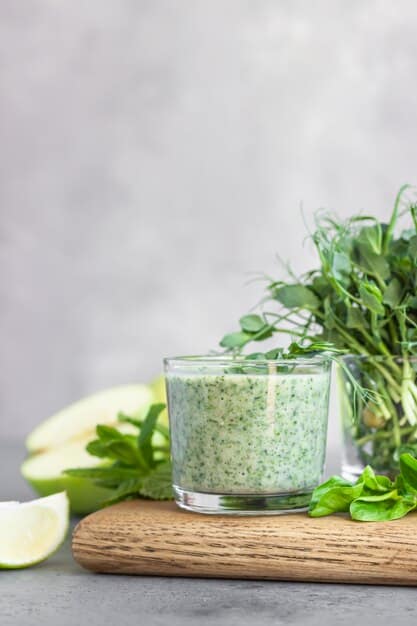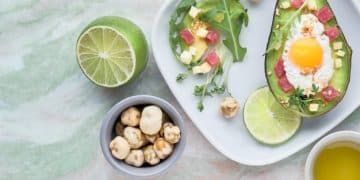7 Ways to Effortlessly Boost Your Veggie Intake

Incorporating more vegetables into daily meals doesn’t have to be a daunting task; strategic and often imperceptible additions can significantly enhance nutritional intake and overall well-being without requiring drastic changes to eating habits.
In a world bustling with convenience foods and hectic schedules, the simple act of eating enough vegetables often takes a backseat. Many of us know we should consume more, but how exactly do we achieve this without feeling like we’re constantly munching on salad or making drastic dietary overhauls? This article explores 7 ways to sneak more vegetables into your diet without even noticing, transforming your meals with hidden nutritional powerhouses.
the art of stealth veggie integration
Adding more vegetables to your diet sounds simple in theory, but in practice, it can often feel like a chore. The good news is that you don’t need to commit to huge, raw salads at every meal. The real secret lies in subtle, almost undetectable additions that boost nutrient density without altering the fundamental appeal of your favorite dishes. This approach is particularly effective for those who are less enthusiastic about vegetables or for families with picky eaters.
The concept behind stealth veggie integration is to make healthy eating an almost unconscious act. Instead of focusing on what you’re “giving up” or forcing yourself to eat foods you don’t enjoy, you’re enhancing what’s already on your plate. This method leverages the versatility of vegetables, allowing them to blend seamlessly into sauces, baked goods, and even beverages, providing essential vitamins, minerals, and fiber.
blending and pureeing for hidden goodness
One of the most effective ways to hide vegetables is by blending or pureeing them into your meals. This method works wonderfully for sauces, soups, and even smoothies. The texture virtually disappears, leaving behind only the flavor and nutritional benefits. It’s a game-changer for dishes like pasta sauce, where a few extra vegetables can go unnoticed yet significantly improve the health profile.
- Pasta Sauces: Add pureed carrots, zucchini, or bell peppers to your tomato sauce. They cook down to a sweet, rich consistency.
- Soups and Stews: Blend cooked cauliflower or butternut squash into creamy soups for added thickness and nutrients without heavy cream.
- Smoothies: Spinach or kale can be blended into a fruit smoothie. The fruit’s sweetness typically masks the greens’ flavor.
grating and finely chopping for invisible additions
Another excellent technique involves grating or finely chopping vegetables so they almost vanish into the dish. This works especially well in ground meat dishes, baked goods, and casseroles. The small size of the pieces allows them to cook quickly and integrate thoroughly, making them difficult to detect by even the most discerning palates.
Consider carrots or zucchini grated directly into meatloaf or meatballs. The moisture from the vegetables can also help keep these dishes tender and juicy. For baked goods, finely grated zucchini or carrots contribute moisture and fiber without an overpowering vegetable taste, often enhancing the overall texture.
breakfast power-ups: start your day right
Breakfast is often overlooked as an opportunity to add vegetables, but it can be one of the easiest meals to fortify. Many breakfast staples can be subtly enhanced with vegetables, setting a healthy tone for the entire day. Unlike lunch or dinner, where heavier flavors might dominate, breakfast often features milder profiles that allow for harmonious vegetable integration.
From scrambled eggs to oatmeal, there are numerous ways to sneak in those extra servings. The key is to think creatively about how vegetables can complement existing breakfast flavors without overpowering them. This can lead to a more balanced meal that provides sustained energy throughout the morning without the mid-morning slump often associated with carb-heavy breakfasts.
scrambled eggs and omelets reinvented
Eggs are a versatile canvas for vegetable additions. Whether you’re making scrambled eggs, omelets, or frittatas, finely diced vegetables can be folded in seamlessly. Bell peppers, mushrooms, spinach, and onions are classic choices, but experiment with grated zucchini or even sweet potato for a surprising twist. These additions not only boost nutrients but also add color and texture.
The heat from cooking helps soften the vegetables, making them less noticeable. For a quick morning meal, chop your vegetables in advance so they’re ready to be tossed into the pan with your eggs. This simple step can significantly elevate a basic breakfast into a nutrient-packed powerhouse.
oatmeal and smoothie bowls: sweet and savory surprises
While often associated with fruits, oatmeal and smoothie bowls can be excellent vehicles for vegetables. For oatmeal, consider grated carrots or zucchini cooked with the oats, turning it into a “carrot cake” or “zucchini bread” inspired breakfast. The sweetness of cinnamon and maple syrup can easily mask the earthy flavors of the vegetables.
- Oatmeal: Stir in grated carrots or zucchini during cooking, along with cinnamon and a touch of sweetener.
- Smoothie Bowls: Blend in spinach, riced cauliflower, or even leftover roasted sweet potato for creaminess and nutrients.
- Vegan Additions: Pureed pumpkin or butternut squash can add creaminess and a nutritional boost to both sweet and savory breakfast dishes.

lunch and dinner cleverness: everyday meals, enhanced
Lunch and dinner are typically the largest meals of the day, offering ample opportunities for vegetable incorporation. However, it’s easy to fall into a routine of serving the same few vegetable sides or none at all. The real trick lies in integrating vegetables directly into the main components of the meal, making them an integral part of the dish rather than an afterthought.
From one-pan wonders to classic comfort foods, nearly every meal can benefit from a hidden vegetable boost. This approach not only makes healthy eating more convenient but also encourages a wider variety of vegetable intake, exposing you to different nutrients and flavors. It’s about making vegetables the supporting actors that quietly elevate the entire performance of your meal.
meat dishes and casseroles: a natural fit
Ground meat dishes like lasagna, meatloaf, chili, and tacos are perfect candidates for hidden vegetables. Finely diced or grated vegetables like onions, bell peppers, carrots, celery, mushrooms, or zucchini can be mixed directly into the meat. They absorb the flavors of the dish and virtually disappear while adding bulk, fiber, and moisture.
Casseroles are equally forgiving. Layering thinly sliced or pureed vegetables into pasta bakes, rice casseroles, or potato gratins can significantly increase their nutritional content. The multiple textures and flavors in a casserole often make it easy to camouflage additional ingredients without detection, making healthy eating a seamless experience for the whole family.
sauces, gravies, and dips: the ultimate hiding spots
Sauces, gravies, and dips are perhaps the most unsuspecting hiding spots for vegetables. Their smooth, consistent textures make it incredibly easy to blend in pureed vegetables without altering the taste or consistency of the original product. This is a fantastic way to boost the nutritional value of even the most basic meals.
Consider a cheese sauce for macaroni and cheese: pureed butternut squash or cauliflower can be added for extra creaminess and a boost of vitamin A, often enhancing the color and richness. For gravies, a little pureed mushroom or onion can deepen the savory flavor. Even dips like hummus can be fortified with roasted bell peppers or carrots, adding a layer of subtle sweetness and nutrients.
- Cheese Sauces: Blend steamed and pureed cauliflower or butternut squash into cheese sauces for pasta or vegetables.
- Gravies: Add pureed mushrooms, onions, or carrots to gravies for depth of flavor and nutrients.
- Dips: Fortify creamy dips with pureed roasted red peppers, spinach, or even cooked sweet potato.
snack time solutions: crunchy, satisfying, stealthy
Snacks are often where healthy eating habits derail, leading to choices that are convenient but low in nutrients. However, snack time can be another prime opportunity to increase your vegetable intake without feeling like you’re making a conscious effort. The key is to transform vegetables into appealing, easy-to-eat forms that satisfy cravings.
From homemade chips to savory muffins, turning vegetables into snackable items makes them more attractive and accessible. This approach can help bridge the gap between meals, ensuring a steady supply of nutrients throughout the day and preventing overeating at main meals by keeping hunger at bay with wholesome options.
homemade veggie chips and crisps
Forget store-bought potato chips; homemade vegetable chips are a delicious and nutritious alternative. Thinly slice vegetables like zucchini, sweet potatoes, kale, or beets, lightly toss them with olive oil and seasonings, and bake until crisp. The crunch factor makes them incredibly satisfying, and you control the ingredients, avoiding unhealthy additives.
These chips are an excellent way to use up leftover vegetables and provide a healthier option for when you crave something salty and crispy. They are also incredibly versatile; experiment with different spices like paprika, garlic powder, or chili flakes to create a variety of flavors. This makes snacking a creative and enjoyable process.
muffins, breads, and bars with a veggie twist
Baked goods aren’t just for fruit; vegetables can add moisture, fiber, and nutrients to muffins, quick breads, and granola bars. Grated zucchini and carrots are classic choices for sweet baked goods, but don’t shy away from options like pureed pumpkin or even finely chopped spinach in savory muffins. The natural sweetness of some vegetables can even reduce the need for added sugar.
These vegetable-enhanced baked goods are perfect for on-the-go snacks or a quick breakfast. They offer a convenient way to get extra nutrients, especially for children who might otherwise resist eating certain vegetables. Preparing a batch at the beginning of the week ensures you always have a healthy, ready-to-eat snack option.

integrating veggies into drinks: beyond the smoothie
While smoothies are a well-known method for consuming vegetables in liquid form, the world of vegetable-infused beverages extends far beyond them. Juicing, infused waters, and even certain hot drinks can provide unique and refreshing ways to increase your daily vegetable intake. These methods often offer a quick and efficient way to absorb nutrients.
The beauty of liquid vegetable consumption is the ease with which nutrients can be absorbed by the body. For those who struggle with chewing a large volume of vegetables, especially raw ones, turning them into a beverage can be a highly efficient alternative. It’s about thinking outside the box and embracing innovative ways to hydrate and nourish simultaneously.
fresh pressed juices: a nutrient shot
If you own a juicer, fresh pressed vegetable juices are a fantastic way to consume a concentrated amount of nutrients. While blending retains fiber, juicing extracts the liquid, providing a potent dose of vitamins and minerals. Carrots, celery, cucumbers, and beets are popular juicing vegetables, often combined with a touch of fruit for sweetness.
Be mindful of the sugar content when adding too much fruit to juices. The goal is to maximize vegetable intake. Starting your day with a small glass of vegetable juice can be a powerful way to kickstart your metabolism and flood your body with essential nutrients, boosting energy levels and promoting overall vitality.
infused waters and teas: subtle veggie flavors
For a more subtle approach, consider infusing your water or tea with vegetable flavors. Slices of cucumber or celery can add a refreshing crispness to plain water. For teas, a thin slice of ginger or a few sprigs of mint can enhance the flavor profile and offer additional health benefits. These infusions are not about providing high volumes of vegetables, but rather making hydration more appealing and nutritious in a gentle way.
This method is excellent for those who find the taste of many vegetables strong or overwhelming. It’s a way to gradually introduce new flavors and slowly expand one’s palate. Infused waters can also be a healthy alternative to sugary drinks, encouraging you to consume more fluids throughout the day while subtly benefiting from vegetable essences.
mindful shopping and preparation: the foundation for success
Ultimately, successfully incorporating more vegetables into your diet, whether hidden or overt, begins with what you bring into your kitchen. Mindful shopping and strategic preparation are the foundational pillars that support all the stealthy techniques discussed. Without a well-stocked pantry and a little foresight, even the best intentions can fall flat.
Planning your meals and snacks ahead of time, even loosely, can make a significant difference. Utilizing fresh, seasonal produce ensures maximum flavor and nutrient content. It also encourages variety, preventing palate fatigue and ensuring a broader spectrum of vitamins and minerals in your diet. This proactive approach turns healthy eating from a challenge into a natural part of your routine.
stocking your pantry for veggie readiness
A well-stocked pantry and refrigerator are your greatest allies. Keep a variety of fresh, frozen, and canned vegetables on hand. Frozen vegetables are just as nutritious as fresh and offer convenience, reducing prep time. Canned vegetables, like diced tomatoes or corn, can be quick additions to many dishes when fresh options aren’t available.
- Fresh Staples: Always have onions, garlic, carrots, and celery on hand for basic cooking.
- Frozen Favorites: Keep bags of spinach, broccoli florets, and mixed vegetables in the freezer for quick additions.
- Canned Goods: Diced tomatoes, various beans, and corn can be pantry powerhouses.
meal prepping for seamless integration
A little bit of meal prepping goes a long way. Dedicate some time each week to washing, chopping, and even partially cooking vegetables. Having prepped vegetables ready to go reduces the mental and physical effort required during busy mealtimes. This makes it far easier to toss a handful of chopped veggies into a stir-fry, an omelet, or a sauce without a second thought.
Consider roasting a large batch of vegetables like bell peppers, zucchini, and sweet potatoes at the beginning of the week. These can then be added to salads, wraps, or used as a base for quick soups and stews throughout the week. This minimizes food waste and maximizes efficiency, making healthy eating a truly effortless endeavor.
| Key Strategy | Brief Description |
|---|---|
| 🍲 Puree Power | Blend vegetables into sauces & soups for invisible nutrients. |
| ✨ Grate & Chop | Finely dice veggies into meat dishes or baked goods. |
| 🍳 Breakfast Boost | Incorporate veggies into eggs, oatmeal, or smoothies. |
| 🥤 Drink It Up | Use juicing or infused waters for liquid veggie intake. |
frequently asked questions
Yes, many vegetables, when pureed or finely chopped, have mild flavors that blend seamlessly into dishes, especially when paired with strong flavors like cheese, herbs, or spices. Carrots, zucchini, and cauliflower are particularly good for this, often adding a creamy texture or natural sweetness without a distinct “vegetable” taste.
Absolutely. Frozen vegetables are often picked at their peak ripeness and flash-frozen, locking in their nutrients. This process can sometimes preserve vitamins better than keeping fresh vegetables for extended periods, making them an excellent-value and equally nutritious option for secret additions to your meals.
For sauces where color preservation is key, consider using white or light-colored vegetables. Cauliflower, zucchini (without the skin), parsnips, and even finely pureed white beans can add creaminess and nutrients without altering the sauce’s hue. You can sometimes get away with orange vegetables like carrots if the sauce is already red or orange-based.
Often, adding vegetables, especially pureed or finely chopped ones, can introduce moisture to a dish, which might slightly alter cooking times or consistency. For example, grated zucchini can make baked goods moister. Adjustments to other liquid ingredients or a slightly longer bake/cook time might be necessary, but usually, the effect is minimal and often beneficial.
The beauty of hiding vegetables is that children often won’t notice them. Focus on their favorite dishes—macaroni and cheese, meatloaf, or even baked goods—and subtly add pureed or grated vegetables. Starting small and gradually increasing the amount can help. You can also involve them in the cooking process, even if they don’t know the “secret ingredient.”
conclusion
Integrating more vegetables into your diet doesn’t have to be a battle of wills or a culinary Everest. By embracing stealthy techniques like pureeing, grating, and strategic meal planning, you can significantly boost your nutrient intake without sacrificing flavor or enjoyment. These methods empower you to make healthier choices almost imperceptibly, transforming your meals into nutrient-dense powerhouses. It’s about smart eating, not restrictive eating, proving that a healthier diet can be both delicious and delightfully unnoticeable.





